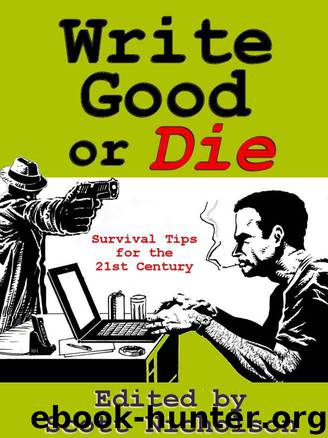Write Good or Die by Nicholson Scott

Author:Nicholson, Scott [Nicholson, Scott]
Language: deu
Format: epub, mobi
Published: 2013-09-28T16:00:00+00:00
Scott Nicholson—http://www.hauntedcomputer.com
###
19. The Three-Act Structure in Storytelling
By Jonathan Maberry
http://www.jonathanmaberry.com
All stories are told in three acts, whether it’s a joke, a campfire tale, a novel, or Shakespeare. The ancient Greeks figured that out while they were laying the foundations of all storytelling, on or off the stage.
Sure, there may be many act breaks written into a script, or none at all mentioned in a novel, but the three acts are there. They have to be. It’s fundamental to storytelling.
Here is the “just the facts” version of this.
The first act introduces the protagonist, some of the major themes of the story, some of the principle characters, possibly the antagonist, and some idea of the crisis around which the story pivots. The first act ends at a turning point moment where the protagonist has to face the decision to go deeper into the story or turn around and return to zero. Often this choice is beyond the protagonist’s control.
In the second act the main plot is developed through action, and subplots are presented in order to provide insight into the meaning of the story, the nature of the characters, and the nature of the crisis. Also, supporting characters are introduced, and we learn about the protagonist and antagonist through their interaction with these characters. The second act ends when the protagonist recognizes the path that will take him from an ongoing crisis to (what he believes is) a resolution.
In the third act, the protagonist races toward a conclusion that will end or otherwise resolve the current crisis and provide a degree of closure. Most or all of the plotlines are resolved, and the protagonist has undergone a process of change as a result of his experiences.
Now, here’s the Three-Act Structure applied to the movie version of The Wizard of Oz.
Download
This site does not store any files on its server. We only index and link to content provided by other sites. Please contact the content providers to delete copyright contents if any and email us, we'll remove relevant links or contents immediately.
| Publishing & Books | Research |
| Writing |
Asking the Right Questions: A Guide to Critical Thinking by M. Neil Browne & Stuart M. Keeley(5649)
Autoboyography by Christina Lauren(5184)
Eat That Frog! by Brian Tracy(4436)
Dialogue by Robert McKee(4323)
Sticky Fingers by Joe Hagan(4103)
Journeys Out of the Body by Robert Monroe(3572)
Annapurna by Maurice Herzog(3424)
Full Circle by Michael Palin(3389)
Schaum's Quick Guide to Writing Great Short Stories by Margaret Lucke(3321)
Elements of Style 2017 by Richard De A'Morelli(3307)
The Art of Dramatic Writing: Its Basis in the Creative Interpretation of Human Motives by Egri Lajos(3017)
Atlas Obscura by Joshua Foer(2900)
The Diviners by Libba Bray(2887)
Why I Write by George Orwell(2877)
In Patagonia by Bruce Chatwin(2876)
The Fight by Norman Mailer(2848)
The Mental Game of Writing: How to Overcome Obstacles, Stay Creative and Productive, and Free Your Mind for Success by James Scott Bell(2845)
Venice by Jan Morris(2526)
The Elements of Style by William Strunk and E. B. White(2442)
